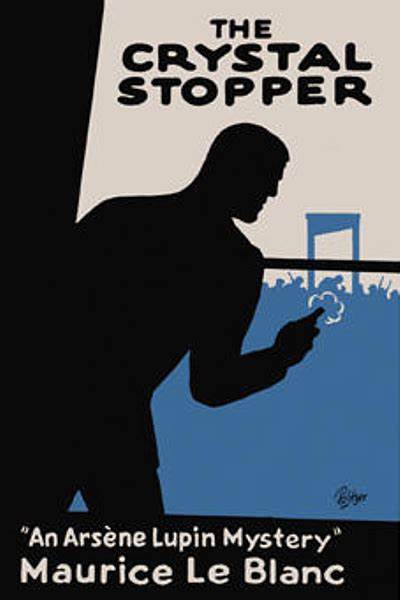Book Review: The Crystal Stopper by Maurice Leblanc
Arsène Lupin should probably have been more cautious when two members of his gang, Vaucheray and Gilbert, asked him to assist with the burglary of the Enghien country home of government deputy Daubrecq. But Vaucheray is experienced, and Lupin is impressed with Gilbert’s good character (for a criminal), and they seem to have done a good job of scouting the place. Up to the point at which they discover the valet Leonard had not in fact gone out after all. It’s necessary to tie the man up and get him out of the way, but now they must hurry to avoid the police.

Lupin has his minions Growler (“Grognard” in the French) and Masher take off with the loot already gathered, but the two other henchmen are taking too long. He re-enters to find that Leonard has been stabbed to death, but not before calling the police earlier than anticipated, and Gilbert and Vaucheray have fallen out over a small bit of treasure. With the police already surrounding the house, Lupin must temporarily abandon his fellows to be rescued later.
When Lupin gets home, he discovers that the bit of loot in contention is a crystal stopper such as might be used for a wine decanter, with a thin gilded coating. It appears to be perfectly ordinary–except that it disappears from his apartment that very night!
Lupin is faced with a number of mysteries. Who murdered Leonard? How did the crystal stopper vanish from his apartment? How many sides are there to this battle? And what is the significance of the crystal stopper, sought by so many including the police?
Things clear up a bit when it’s learned that Deputy Daubrecq got his money and government position through blackmail. He possesses a piece of paper known as “The List of Twenty-Seven” that would ruin that number of men if it ever came into the hands of the authorities. Somehow, the crystal stopper contains a clue to the hiding place of that list. If Lupin can get his hands on that list, he can save his gang members from execution. Plus, by now there’s a beautiful woman involved who has personal beef with Daubrecq and vice-versa, with ties back to why he turned to crime in the first place.
This 1912 novel is a bit unusual in that Lupin, instead of being two steps ahead of all opposition is outfoxed repeatedly by Daubrecq, and is running ragged for much of the story. There’s even a thrilling sequence in which Lupin has to rescue Daubrecq from another villain only to have the blackmailer betray him in the middle of the rescue. Of course, our protagonist turns it around at the end, but it’s a nearer thing than ever before, and Lupin has to settle for a partial victory in one instance.
Since early translations of the book are in the public domain, my copy used some language obscure to modern audiences. For example, younger readers might not know that “foreign-post paper” aka onion skin paper is a special kind of exceedingly thin and light but strong paper used to save postage costs (and when airmail came in, weight in the airplane.)
It should be mentioned that Maurice LeBlanc is a character in the book himself, and got all his information straight from Lupin during one of their conversations about the master thief’s past adventures.
Content note: Lupin does not torture people himself, but is willing to condone it being done by other people when it’s to his advantage, so there’s an on-page torture sequence. One of Daubrecq’s motivations is forcing Clarisse to marry him and his behavior towards her is as creepy as you’d expect. Suicide. Lupin casually mentions that he has a promiscuous sex life, though he doesn’t indulge during the course of the story. And, well, Lupin is a criminal who regularly steals and tricks people. He’s the hero because his enemy is a much worse person.
In this story, Lupin is very much the dashing, sympathetic rogue so many other works try and fail to convince us their characters are. His cleverness and clear moral boundaries help establish why we’re following him through the story rather than say Prasville, the secretary-general of the police. There’s plenty of twists and turns to keep up interest, and sure we know that Lupin will survive, but everyone else is fair game. You might want to start with The Hollow Needle or one of the short story collections to get a feel for Lupin when he’s on top, but this is a fun book for fans of master thieves.
Shout out to Kayt, who gave me this book for the blog’s tenth anniversary.


Upon encountering a certain name in this review, I felt compelled to double check. Clarisse Mergy, who appears in this novel, is not Clarisse d’Étigues, the first great love of Lupin’s life, after a whom a certain princess was named.
Lupin just seems to have a weakness for women named Clarisse.